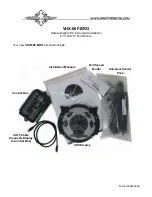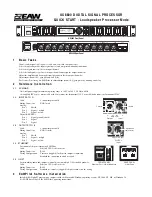
80
For transmitters rated at a maximum output power not listed above, the
recommended separation distance d in meters (m) can be estimated
using the equation applicable to the frequency of the transmitter, where
P is the maximum output power rating of the transmitter in watts (W)
according to the transmitter manufacturer.
NOTE 1. At 80 MHz and 800 MHz, the separation distance for the higher
frequency range applies.
NOTE 2. The ISM (industrial, scientific and medical) bands between 150
kHz and 80 MHz are 6.765 MHz to 6.795 MHz; 13.553 MHz to
13.567 MHz; 26.957 MHz to 27.283 MHz; and 40.66 MHz to
40.70 MHz.
NOTE 3. An additional factor of 10/3 is used in calculating the
recommended separation distance for transmitters in the ISM
frequency bands between 150 kHz and 80 MHz and in the
frequency range 80 MHz to 2.5 GHz to decrease the likelihood
that mobile/portable communications equipment could cause
interference if it is inadvertently brought into patient areas.
NOTE 4. These guidelines may not apply in all situations.
Electromagnetic propagation is affected by absorption and
reflection from structures, objects and people.
10.7
Rhythm Recognition Performance
The AED7000 Plus algorithm exceeds the requirements of
ANSI/AAMI DF39-1993.
Section 3.3.18 and the sensitivity and specificity levels recommended
by the AHA Automatic External Defibrillators for Public Access Use:
Recommendations for Specifying and Reporting Arrhythmia Analysis
Algorithm Performance.
The test database includes shockable rhythms consisting of ventricular
fibrillation rhythms (>150uV) and wide-complex ventricular
tachycardia at a rate greater than 140 BPM. Non-shockable rhythms
include various sinus rhythms including supraventricular tachycardia,
atrial fibrillation, atrial flutter, sinus rhythm with PVC's, asystole,
pacemaker rhythms, and ventricular tachycardia with a rate less than
140 BPM and/or narrow complexes.




































